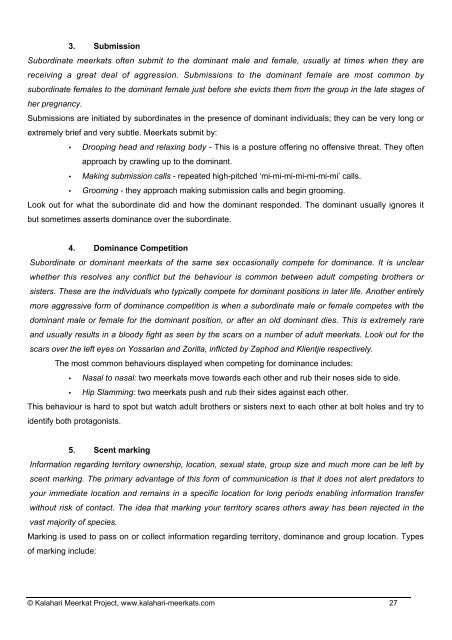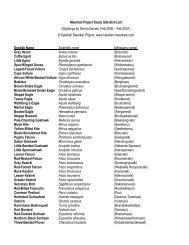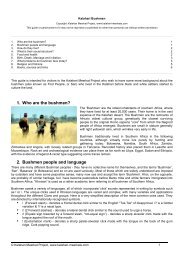Earthwatch Field Guide - The Kalahari Meerkat Project
Earthwatch Field Guide - The Kalahari Meerkat Project
Earthwatch Field Guide - The Kalahari Meerkat Project
Create successful ePaper yourself
Turn your PDF publications into a flip-book with our unique Google optimized e-Paper software.
3. SubmissionSubordinate meerkats often submit to the dominant male and female, usually at times when they arereceiving a great deal of aggression. Submissions to the dominant female are most common bysubordinate females to the dominant female just before she evicts them from the group in the late stages ofher pregnancy.Submissions are initiated by subordinates in the presence of dominant individuals; they can be very long orextremely brief and very subtle. <strong>Meerkat</strong>s submit by:• Drooping head and relaxing body - This is a posture offering no offensive threat. <strong>The</strong>y oftenapproach by crawling up to the dominant.• Making submission calls - repeated high-pitched ‘mi-mi-mi-mi-mi-mi-mi’ calls.• Grooming - they approach making submission calls and begin grooming.Look out for what the subordinate did and how the dominant responded. <strong>The</strong> dominant usually ignores itbut sometimes asserts dominance over the subordinate.4. Dominance CompetitionSubordinate or dominant meerkats of the same sex occasionally compete for dominance. It is unclearwhether this resolves any conflict but the behaviour is common between adult competing brothers orsisters. <strong>The</strong>se are the individuals who typically compete for dominant positions in later life. Another entirelymore aggressive form of dominance competition is when a subordinate male or female competes with thedominant male or female for the dominant position, or after an old dominant dies. This is extremely rareand usually results in a bloody fight as seen by the scars on a number of adult meerkats. Look out for thescars over the left eyes on Yossarian and Zorilla, inflicted by Zaphod and Klientjie respectively.<strong>The</strong> most common behaviours displayed when competing for dominance includes:• Nasal to nasal: two meerkats move towards each other and rub their noses side to side.• Hip Slamming: two meerkats push and rub their sides against each other.This behaviour is hard to spot but watch adult brothers or sisters next to each other at bolt holes and try toidentify both protagonists.5. Scent markingInformation regarding territory ownership, location, sexual state, group size and much more can be left byscent marking. <strong>The</strong> primary advantage of this form of communication is that it does not alert predators toyour immediate location and remains in a specific location for long periods enabling information transferwithout risk of contact. <strong>The</strong> idea that marking your territory scares others away has been rejected in thevast majority of species.Marking is used to pass on or collect information regarding territory, dominance and group location. Typesof marking include:© <strong>Kalahari</strong> <strong>Meerkat</strong> <strong>Project</strong>, www.kalahari-meerkats.com 27





